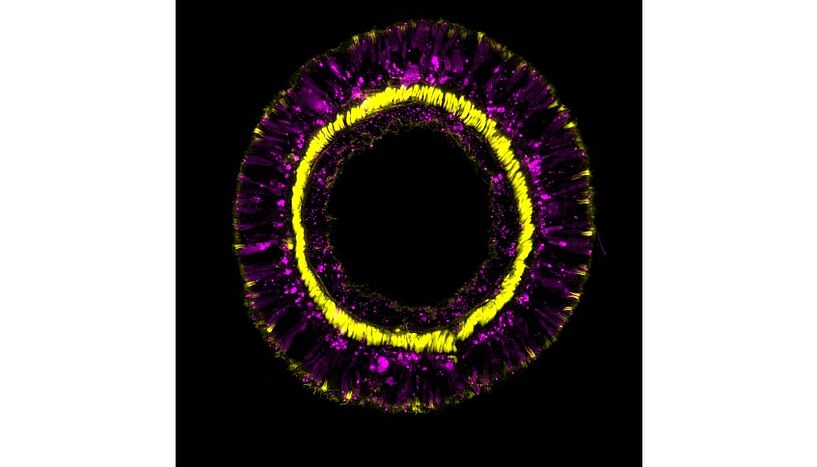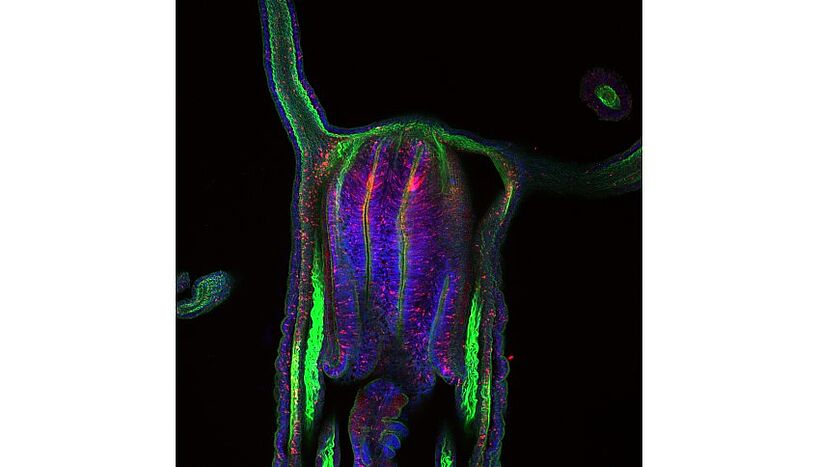Old genes keep sea anemones forever young
20. September 2022Highly conserved genes ensure lifelong differentiation of neurons and glandular cells in sea anemones
The genetic fingerprint of the sea anemone Nematostella vectensis shows that the members of this evolutionarily very old animal phylum use the same gene cascades for the differentiation of neuronal cell types as more complex organisms. These genes are also responsible for the balance of all cells in the organism throughout the anemone’s life. The results were published by a team of developmental biologists led by Ulrich Technau of the University of Vienna in "Cell Reports".
Almost all animal organisms are made of millions, if not billions of cells that group together in complex ways to form specific tissues and organs, which consist of multiple different cell types, such as a variety of neurons or gland cells. How this important balance of diverse cell types arises, how it is regulated, and whether the different cell types of different animal organisms have a common origin is not well understood.
Single-cell fingerprint leads to common ancestors
The research group, led by evolutionary developmental biologist Ulrich Technau, who is also head of the Single Cell Regulation of Stem Cells (SinCeReSt) research platform at the University of Vienna, has deciphered the diversity and evolution of all nerve and gland cell types and their developmental origins in the sea anemone Nematostella vectensis. In order to achieve this, they used single cell transcriptomics, a method that has revolutionized biomedicine and evolutionary biology over the past decade. "With this, entire organisms can be resolved into single cells - and the entirety of all currently expressed genes in each individual cell can be decoded. Different cell types fundamentally differ in the genes they express. Therefore, single cell transcriptomics can be used to determine the molecular fingerprint of each individual cell," explains Julia Steger, first author of the current publication. In the study, cells with an overlapping fingerprint were grouped. This allowed the scientists to distinguish defined cell types or cells in transitional stages of development, each with unique expression combinations. It also allowed the researchers to identify the common progenitor and stem cell populations of the different tissues. To their surprise, they found that, contrary to earlier assumptions, neurons, glandular cells and other sensory cells originate from one common progenitor population, which could be verified by genetic labeling in living animals. Since some gland cells with neuronal functions are also known in vertebrates, this could indicate a very old evolutionary relationship between gland cells and neurons.
Ancient gene in constant use
One gene plays a special role in the development of these common ancestor cells. SoxC is expressed in all precursor cells of neurons, gland cells and cnidocytes and is essential for the formation of all these cell types, as the authors were additionally able to show in knockout experiments. "Interestingly, this gene is no stranger: It also plays an important role in the formation of the nervous system in humans and many other animals, which, together with other data, shows that these key regulatory mechanisms of nerve cell differentiation seem to be conserved across the animal kingdom," says Technau. By comparing different life stage, the authors also found that in sea anemones, the genetic processes of neuron development are maintained from the embryo to the adult organism, therefore contributing to the balance of neurons throughout the life of Nematostella Vectensis. This is remarkable because, unlike humans, sea anemones can replace missing or damaged neurons throughout their lives. For future research, this raises the question of how the sea anemone manages to maintain these mechanisms, which in more complex organisms only occur in the embryonic stage, into the adult organism in a controlled manner.
Publication:
Julia Steger, Alison G. Cole, Andreas Denner, Tatiana Lebedeva, Grigory Genikhovich, Alexander Ries, Robert Reischl, Elisabeth Taudes, Mark Lassnig, and Ulrich Technau. Single cell transcriptomics identifies conserved regulators of neuroglandular lineages. Cell Reports, 2022.
Figures:
Fig. 1 (Abb. 1): Cross-section through a tentacle of a transgenic sea anemone showing differentiation products of the SoxC cell population (magenta) and retractor muscles (yellow). (C: Andreas Denner)
Fig. 2 (Abb. 2): Optical longitudinal section of a sea anemone with nanos1-transgenic neuronal cells (red) in both cell layers. Muscles are stained green, cell nuclei in blue. (C: Andreas Denner)
Scientific contact
Univ.-Prof. Dipl.-Biol. Dr. Ulrich Technau
Department für Neurowissenschaften und EntwicklungsbiologieUniversität Wien
1030 - Wien, Djerassiplatz 1
+43-1-4277-57000
+43-664-8175529
ulrich.technau@univie.ac.at
Further inquiry
Mag. Alexandra Frey
Media Relations ManagerUniversität Wien
1010 - Wien, Universitätsring 1
+43-1-4277-17533
+43-664-8175675
alexandra.frey@univie.ac.at
Downloads:
20220920_Technau_Abb1.jpg
File size: 185,74 KB
20220920_Technau_Abb2.jpg
File size: 221,62 KB


